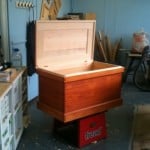How square should a square be?
Welcome! / Forums / General Woodworking Discussions / Tools and Tool Maintenance/Restoration / How square should a square be?
Tagged: combination square, square, stanley, tool
- This topic has 33 replies, 20 voices, and was last updated 9 years, 8 months ago by
kodi.
-
AuthorPosts
-

I know I’m reviving very old thread. Two months ago I started my adventure with woodworking. One of the tools I bought was – yep you guessed right – a combi square made by Draper. It was an only piece in the shop, so I didn’t have much choice. Of course at home when i tried to do four face line on the piece, the line from the first and fourth faces didn’t met. So I purchased Stanley combi square from Amazon (yep, here in Irish Wild West we don’t have fancy tools in shops) – exactly . Happy that finally have a perfect tool, went back to work. The error this time was even bigger and checking the square unearthed few issues:
– faces are not flat, but concave
– ruler is not straight, it literally produces waves if you want to draw a line
– the square error at the end is a little under 5 mm.
– the second day of use, locking nut just stuck. It can be removed with excessive force
So I asked Amazon for replacement. This time the square error is just about 3 millimeters (still worse than Draper), and the slit where the ruler sits is just too wide so you cannot lock the ruler parallel to the axis of symmetry of the sole. Ruler itself is fine.
I doubt Amazon will agree to replace it the next time so my idea is to build one square from those two, but to do this – is there any manual how to do this properly? Stanleys don’t have those small nibs that Draper does, so square correction will be probably a little more difficult.
PS: Draper square after just few strokes of the file is now perfectly square. What’s going on, Stanley? 11 August 2014 at 3:20 pm #60229
11 August 2014 at 3:20 pm #60229Well, if Amazon won’t take it back (and if they don’t, stop buying tools there) then that Stanley sounds like it should be simple to fix with a good hammer. It will still be useless as a square but if you hit it just right it will prevent anyone else from mistaking it for a useful tool.
Sad to say, Stanley is off my new tools list permanently. Some time back I also bought a Stanley tool from Amazon. It was a four in hand file (half round rasp and file) and it was a mess. One surface just had shallow grooves cut in it over the center part. There were no teeth at all!
It’s a strange world. You can buy someone’s grandfather’s toolbox that’s been kicking around the garage for a century or more and wind up with better tools than you can buy new off the shelf that someone is spending millions of dollars to advertise.
Paul has a number of articles on buying good tools cheap and he’s not shy about telling it like he sees it. Worth the searching and reading time in my opinion.
Good luck,
John
I was considering sending them back to Amazon, but in the meantime my friend called with some tools and I HAD to have a working square, to cut the timber. So I went to 2Euro store, got a pack of needle files and started to fix what Stanley couldn’t make right at the first time. I drew some square lines using the divider as a reference (the best way to draw a perfect square) and closely assessed what had to be done. I selected the one iron that had a narrower slit (more about it later). The 45 degree angle faces were perfectly ok, so off we go to lap the third one. I got myself a guarantee flat granite block, so I knew I can do this. Next the ruler – again selected one that was more true and I could assess if it has parallel sides. It was close enough, so again – lapping plate, granite and some thin paper charged with chromium oxide (the one thing I know how to do right is sharpening, so took it slowly step by step). At the end of the process there was no light gaps between the ruler and the granite block itself and the ruler side got mirror finish (which was later on used to assess the squareness of the square). As the iron I used was the one where the nut was locking I took a minute to see what is going on. It occurred the place where the bolt is located had some extra iron from the casting process. Flat file and some polishing took care of that. So I now have square, working iron sole and good ruler. Time to make them work together. Checked the squareness – awful. 4mm at the end. Light, magnifying glass and few moments later I noticed that the bottom of the slit is uneven. Flat needle file, 20 or so tries later and got it flat and parallel to the face. Check for squareness shows almost good. I took the second ruler (wavy beyond repair), put some chromium oxide on the side of it and carefully started to polish the bottom of the slit, giving a little more pressure where needed. Check for squareness shows perfect match from both sides, and mirror image on the side of the ruler confirms it. So after about 3.5 hours I finally got my working combi square. My friend in meantime went to do some of his business, came back with a box. He said “you need some tools if you want to do woodworking – here, open this”. I opened the box – spokeshave! Yay! My friend says “yep, brand new #151 Stanley, good make”. I thanked for the gift and we went to cut the timber. Later on I took Paul’s book and started to adjust the spokeshave. It quickly occured – I have very limited iron movement, because the threaded rods are not parallel. REALLY, STANLEY?
-
AuthorPosts
- You must be logged in to reply to this topic.
